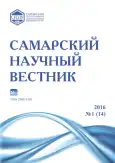К вопросу классификации экосистем юго-востока Украины
- Авторы: Остапко В.М.1, Шевчук О.М.2, Приходько С.А.1
-
Учреждения:
- Донецкий ботанический сад
- Никитский ботанический сад - Национальный научный центр РАН
- Выпуск: Том 5, № 1 (2016)
- Страницы: 41-47
- Раздел: 03.02.00 – общая биология
- URL: https://journals.rcsi.science/2309-4370/article/view/21961
- DOI: https://doi.org/10.17816/snv20161109
- ID: 21961
Цитировать
Полный текст
Аннотация
Рассматриваются современные подходы к классификации экосистем, как инструменту познания их разнообразия и связи с географическими и экологическими системообразующими факторами, а также для решения практических задач по их охране и рациональному природопользованию. Предлагается классификация экосистем юго-востока Украины, основанная на доминантной классификации растительности. В основу классификации положено разделение экосистем по типу макроэкотопа (водораздельный, овражно-балочный, надпойменно-террасовый, пойменный) и эдафотопа (развитые чернозёмы, смытые чернозёмы на каменистых обнажениях песчаников, сланцев, гранитов, мергеля, известняка, мела, песчаные и луговые почвы). В основу разделения экосистем на одном и том же уровне каждого класса положены разные признаки: топические, физиономические, эдафические, динамические. Классификация построена по иерархическому принципу. Класс природных экосистем с доминированием фанерофитов включает экосистемы хвойных лесов и экосистемы лиственных лесов неморального типа, представленных в основном равнинно-водораздельными, пойменными и овражно-балочными (байрачными) дубравами. Класс природных злаково-травяных и кустарничковых экосистем представлен водно-болотными, луговыми и очень разнообразными степными экосистемами. Оба класса включают экосистемы разной степени увлажнения и смытости чернозёмов, а также приуроченности к эдафотопам, развитым на выходах различых горных пород. Класс антропогенных экосистем лишь намечен и нуждается в дальнейшей детализации. Приведены списки формаций и субформаций растительности, входящих в экосистемы низших ступеней иерархии.
Ключевые слова
Полный текст
Открыть статью на сайте журналаОб авторах
Владимир Михайлович Остапко
Донецкий ботанический сад
Автор, ответственный за переписку.
Email: ostapko@mail.ru
доктор биологических наук, заместитель директора
Украина, ДонецкОксана Михайловна Шевчук
Никитский ботанический сад - Национальный научный центр РАН
Email: oksana_shevchuk1970@mail.ru
доктор биологических наук, заведующий лабораторией ароматических и лекарственных растений
Россия, Республика Крым, пгт НикитаСветлана Анатольевна Приходько
Донецкий ботанический сад
Email: zura_nsh@mail.ru
кандидат биологических наук, директор
Украина, ДонецкСписок литературы
- Дидух Я.П., Шеляг-Сосонко Ю.Р. Сущность классификации // Продромус растит. Украины. Киев: Наук. думка, 1991. С. 12-23.
- Convention on biological diversity, 1992. 31 p.
- Davies C.E., Moss D. EUNIS Habitat Classification. Final Report to the European Topic Centre on Nature Conservation. European Environment Agency. 1999. 256 p.
- Дідух Я.П. Методологічні підходи до створення класифікації екосистем // Укр. ботан. журн. 2004. 61, № 1. С. 12-23.
- Davies C.E., Moss D. EUNIS Habitat Classification. Final Report. European Topic Centre on Nature Conservation. Paris. 1997. 99 p.
- Davies C.E., Moss D. EUNIS Habitat Classification. Database and Parrte Frame for a European Classification. European Topic Centre on Nature Conservation. Paris. 1997. 15 p.
- Davies C.E., Moss D., Hill M.O. EUNIS Habitat Classification Revised. European Topic Centre on Nature Conservation. Paris, 2004.
- Василевич В.И. Очерки теоретической фитоценологии. Л.: Наука, 1983. 247 с.
- Chytry М., Kucera Tomás, Kocí Martin. Katalog biotope Ceské republiky. Praha: Agentura ochrany přírody a krajiny ČR, 2001. 304 s.
- Haeupler D. Biotope Deutschlands // Schrift. F. Vegetationsk. 2002. H. 38. S. 247-272.
- Дідух Я.П., Шеляг-Сосонко Ю.Р. Класифікація екосистем - імператив національної екомережі України // Укр. ботан. журн. 2001. 58, № 4. С. 393-403.
- Ткачик В.П. Методика виявлення, картування і типізації біотопів. Львів, 1997. 34 с.
- Чёрная Г.А. Классификация переувлажненных екосистем Лесостепи Украины // V Все рос. Конф. По водным растениям «Гидроботаника 2000»: Тез. докл. Борок, 2000. С. 233-234.
- Дідух Я.П. Теоретичні підходи до створення класифікації екосистем // Укр. фітоценот. збірник. Серія С. Фітоекологія. Вип. 23. Фітосоціоцентр, 2005. С. 3-15.
- Остапко В.М. Продромус естественной растительности юго-востока Украины. Донецк, 1995. 142 с.
- Глухов О.З., Остапко В.М., Шевчук О.М., Суслова О.П., Приходько С.А. Класифікаційна схема екосистем в межах південного сходу України // Відновлення порушених природних екосистем: Матеріали Третьої міжнародної наукової конференції (м. Донецьк, 7-9 жовтня 2008 р.). Донецьк, 2008. С. 23-29.
- Рослинність УРСР. Природні луки. К.: Наук. думка, 1968. 256 с.
- Рослинність УРСР. Степи, кам’янисті відслонення, піски. К.: Наук. думка, 1973. 428 с.
- Лавренко Е.М. Степи СССР // Растительность СССР: В 5 т. М., Л.: Изд-во АН СССР, 1940. Т. 2. С. 1-266.
- Лавренко Е.М., Карамышева З.В., Никулина Р.И. Степи Евразии. Л.: Наука, 1991. 146 с.
- Лавренко Е.М. Эдафические варианты степной растительности Причерноморской степной провинции // Растительность Европейской части СССР. Л.: Наука, 1980. С. 249-254.
- Природа Украинской ССР. Климат / Отв. ред. М.И.Щербань. Киев: Наукова думка, 1984. 232 с.
- Національний атлас України / НАН України, Інститут географії, Державна служба геодезії, картографії та кадастру; голов. ред. Національного атласу України Л.Г. Руденко; голова ред. кол. Б.Є. Патон. К.: ДНВП «Картографія», 2007. 435 с.
- Бурда Р.И. Антропогенная трансформация флоры. Киев: Наук. думка, 1991. 167 с.
- Приходько С.А., Остапко В.М., Купрюшина Л.В. Синтаксономічна різноманітність рослинності Південного Сходу України в аспекті синфітосозології // Промышленная ботаника. 2012. Вып. 12.С. 53-60.
Дополнительные файлы






